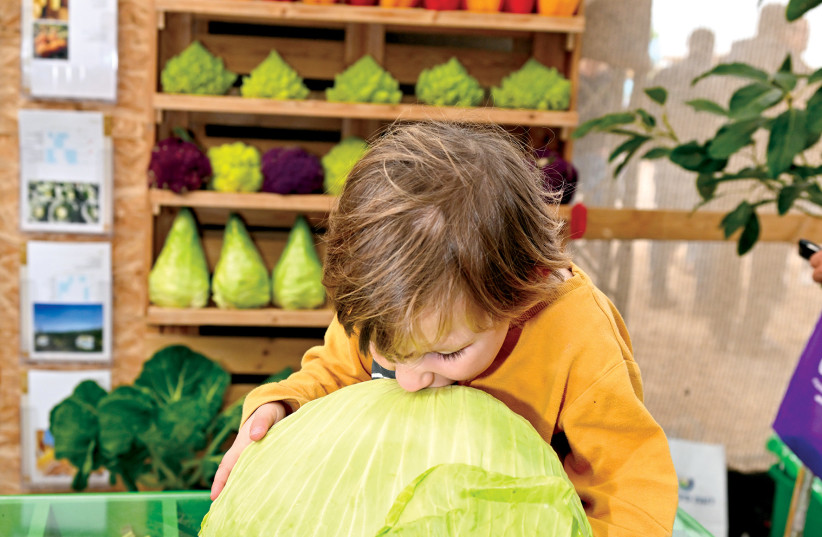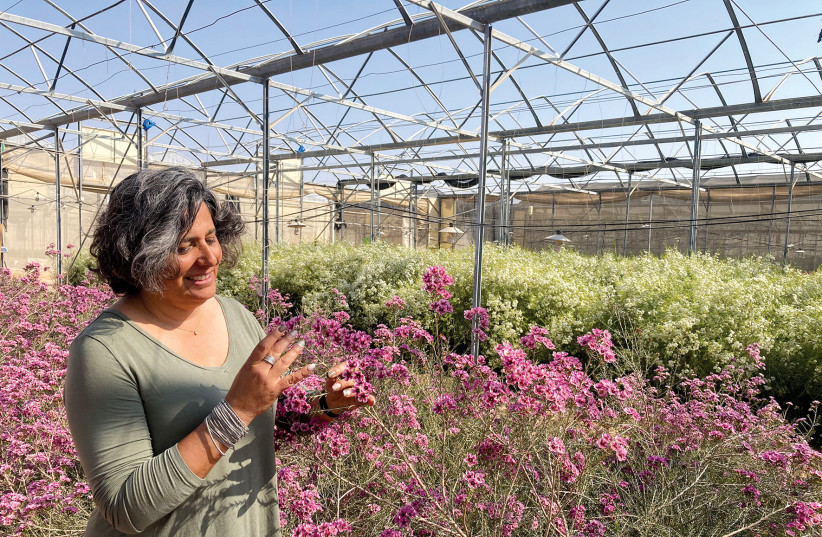As you drive down the steep, winding road from Arad to the Arava Valley, you might wonder how anyone can survive in this barren environment. Located between the towering Edom Mountains of Jordan and the hills of the Negev, much of the area is still pristine wilderness with a stark natural beauty.
Some 130 kilometers north of Eilat along the Israeli-Jordanian border, this arid desert region is considered the most remote part of the country. Yet, in all seven of the central Arava communities – five moshavim (Idan, Hatzeva, Ein Yahav, Zofar and Paran) and two community settlements (Sapir and Zukim) – there are waiting lists of people who want to move there.
When Samantha Levy first arrived in the Arava in 2009 as a new bride from Colombia, there were almost no houses and no place to live. “If you didn’t fall in love with a farmer, you wouldn’t be able to live here. There was no proper medical center, the conditions were really hard, many people left,” says Levy, today a member of the Resource Development team of the Central Arava Regional Council.
“If you didn’t fall in love with a farmer, you wouldn’t be able to live here. There was no proper medical center, the conditions were really hard, many people left.”
Samantha Levy
“There was a very high risk that if we didn’t develop the Arava with infrastructure, places to live, employment, quality of life, education, health, security, we wouldn’t be able to survive. No one would come. To bring people here, you need to provide water, sewage, a place to build a house and, of course, employment.”
THAT WAS then. The transformation in the past 10 years of the central Arava desert communities is nothing less than astonishing. The population has nearly trebled, with 8,000 permanent residents in the south and central Arava, as well as 1,000 foreign agricultural students. The central Arava’s 600 agricultural farms today produce more than 50 percent of Israel’s fresh vegetable exports and a sizable percentage of its cut flower exports. This despite an average yearly rainfall of only two inches.

“There’s been so much development, so many projects here,” Levy says, adding that the region now enjoys high-end services, schools bursting at the seams, and a world-class medical center in Sapir, where there’s a new sports center with an Olympic swimming pool. Wait. What? An Olympic pool?
Where does the Arava get its water from?
The Arava is not connected to the national water system. Virtually all the water for the region comes from the aquifer one and a half kilometers beneath the surface, which is extracted via 63 drilling wells. This brackish (saline) groundwater is used for irrigating crops and is funneled to desalination plants for drinking water and domestic use.
The idea for the successful utilization of groundwater in the Arava began in the 1950s. Though agronomists insisted at the time that it was impossible to grow crops in the sandy wasteland, the now legendary hydrologist Prof. Arie Issar argued that the Arava desert sat atop groundwater that could be used for agriculture. It was Issar’s findings which ultimately enabled the development of the Negev and the Arava.
Some of the major inventions, innovations and patents in the sphere of water usage and agriculture come from Israel’s southern Negev region, a living laboratory of arid lands science and technology. (One of Israel’s greatest innovations is the drip irrigation system, invented and developed in the mid-1960s.)
Oren Korin, the CEO of the Arava Water and Drainage Authority, the local water expert and successful date farmer, explains that the non-potable brackish underground water is not suitable for all the crops but that dates, watermelons, grapes and peppers do flourish with it. “Most of the crops last for only one season because of the salt build-up which blocks the flow of water. But if we could irrigate with desalinated water, the crops could last 40 years.”
But the underground aquifer is not an unlimited source. “The water system is delicate, and without recharging, it wouldn’t be sustainable,” adds Korin. The replenishment is done through agricultural drainage and occasional flooding during the winter rains, captured by reservoirs. Each moshav has a wastewater facility and its own desalination plant for drinking water and domestic use. Thus, the ability to fill the swimming pool.
The engine behind the development of the physical infrastructure, the creation of job opportunities, and the enhancement of the region’s quality of life in the Arava was provided by the Jewish National Fund – USA’s Blueprint Negev campaign launched at the beginning of the 21st century to help “develop the Negev Desert in a sustainable manner to make it home to Israel’s next generation.” The plan to help solve the immediate financial and bureaucratic problems regarding the building process is part of the JNF-USA’s Housing Development Fund plan. While many of the JNF-USA’s ambitious projects in the first decade of the campaign were aimed for the southern city of Beersheba (which is now undergoing exceptional development), the campaign was expanded to include the Arava.
Korin, who was born and raised in the Arava and whose father was one of the pioneer farmers in the region, admits being amazed at the enormous growth of the area and the high demand for housing. “In 2014, I was skeptical that anyone who wasn’t a farmer would come to live in the Arava. The mayor at the time wanted to create 100 lots, and I said, ‘You’re crazy. Who would come to live here?’ He said, ‘You’ll see.’ Now all the lots on our moshav Hatzeva have been sold, and people are building houses. There’s a waiting list for every community planning extensions. This is amazing,” he marvels.
In addition to the farmers and their families, residents include research scientists, teachers and medical staff. But other professionals are moving there as well. “The COVID pandemic changed all the rules,” Korin points out. “It taught us that you can work from home. Lawyers, graphic designers, hi-tech people, etc., can provide services from far away. You don’t have to live in Tel Aviv.”
GIANT CABBAGES, long shushka peppers, juicy, sweet tomatoes, strawberries to die for – these “niche” crops are all grown in the Arava desert. The biggest crop in the region is peppers – the best you’ll ever taste. But other produce grown there include table grapes, watermelons, dates, asparagus, broccoli, eggplants, zucchini, mangoes, goldenberries, and the weird hybrid called cucamelon. Most are grown between September and May to take advantage of the mild winters, compared to the European climate. (Most Israeli consumers won’t find this heavenly produce in their local markets; most of it goes to Europe, though locally produced dates reach global markets.)
Almost everything can be grown in the region, actually, if adjustments are devised in the way the plant reacts to salinity and climate. That challenge, in large measure, is the job of the R&D (research and development) center located in the Arava: how much shade to provide, what fertilizers can be used to improve yields. The experimental greenhouses research what future crops might be feasible, since competition with Europe, especially Spain, is demanding.
Welcome to “the Silicon Valley” of Israeli agriculture. The JNF’s catchy slogan is “The Arava is where fertile minds meet barren soil.”
In addition to agriculture, the R&D in the Arava focuses on biotechnology, aquaculture and ecology. One of the most revolutionary research projects involves mining the components of desert plants to treat neuro degenerative diseases. Another is developing the extract of the myrrh plant (“mor” of the Bible) as a basis for cosmetic and pharmaceutical products.

Most of the researchers are connected to Ben-Gurion University of the Negev and live in the region. “When we set up the labs with JNF-USA, the idea was to generate more job opportunities and bring more families to the region. That was the deal,” says Levy.
ALL THIS success and innovative energy was on display at the recent two-day Agricultural Exhibition and Open Day next to Moshav Hatzeva. The huge event attracted 30,000 visitors from all over the country (because of a last-minute change of dates due to the weather, there were fewer visitors from abroad this year). The First Arava Conference for Innovation in Agriculture and the Outstanding Start-up Competition was held as part of the expo.
Some 200 companies showcased their products and innovations in the various pavilions. Exhibitors included vegetable seed businesses; water and irrigation system companies; advanced monitoring systems, mechanical tools, solar industries, fertilizer companies; and feed production for livestock. (This writer’s favorite was a company that developed a new variety of bite-size cauliflowers.). One could even buy a brand new John Deere tractor at the fair. Left-over produce? Leket Israel, the food rescue NGO that collects and distributes surplus food to the needy, was also represented.
THE NEWEST project of the Arava Regional Council is a joint initiative with the University of Arizona and JNF-USA to introduce innovative technology to vulnerable communities — especially in arid lands — suffering from a lack of food, water, and energy security. The Kasser Joint Institute for Food, Water and Energy Security, set up in 2019, will implement the first pilot in Kenya later this year. “We were looking for places that are similar in climate and structure to the Arava and Arizona,” explains Joint Institute executive director Tania Pons Alon. “Most of the farmers in Kenya are not connected to water, sewage or electricity. The idea is to share the knowledge gained here in the Arava desert.” There are nine institutions that are partners in the project.
“This is a very different project than what the JNF usually does,” she adds. “But in addition to putting Israel in a positive light, this project will also help the Arava because the funding goes to the researchers who live here and will ultimately attract more people.” ■
